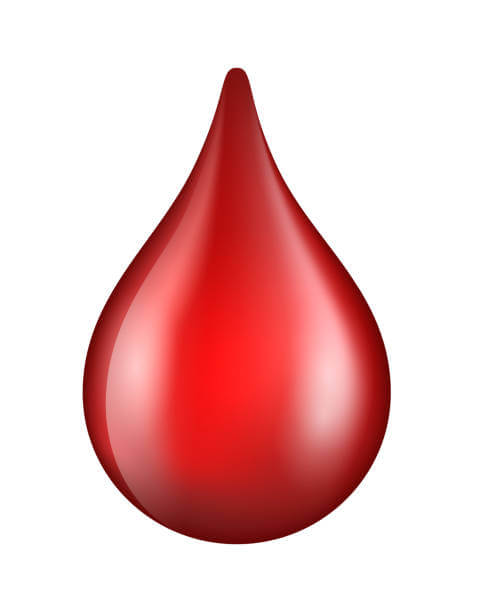What Is Blood-Read Interesting Facts About It
WHAT IS BLOOD
INTRODUCTION-
Hey readers, we all have noticed, if few drops of blood are oozes out through any injury. We just get scared. But for a couple of seconds, did we try to think deeply about it.
If some of you don’t know much about it then through this article, I just want to tell you about its interesting facts. Along with getting knowledge, you will enjoy reading this.
BLOOD-
Blood is needed to keep us alive. It brings oxygen and nutrients to all parts of the body so they can keep working. It carries carbon dioxide and other waste materials to the lungs, kidneys and digestive system to be removed from the body.
It also fights infections and carries hormones around the body. The pure or oxygen-rich or oxygenated blood is pumped by the heart and goes to all parts of the body through arteries.
On the other hand, the impure blood/deoxygenated blood (lower oxygen and higher waste products, which are to be removed or excreted) come back to the heart through veins, it will be cleared by the following image.
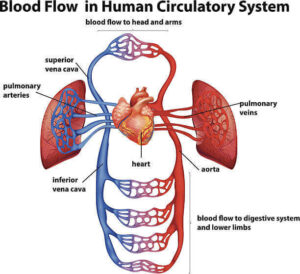
Blood, a red viscous fluid, is connective tissue. It carries oxygen, other essential nourishment through arteries to every living tissue in the body and dispels carbon dioxide, other waste products generated during metabolism through the veins, such as urea. Blood controls the body temperature and defends a person against infections.
QUANTITY AND PRODUCTION –
You make millions of blood cells every day. Each type of cells has an expected life span. For example, red blood cells normally last about 120 days. Some white blood cells last just hours or days, some last longer.
Every day millions of blood cells die and are broken down at the end of their life span. There is normally a fine balance between the number of blood cells that you make and the number that dies and is broken down.
Various factors help to maintain this balance. For example, certain hormones in the bloodstream and chemicals in the bone marrow called growth factors, help to regulate the number of blood cells that are made.
For example, Erythropoietin is a hormone made in the kidneys which increases the production of red blood cells and is used to treat some blood disorders. It is also known as EPO and is one of the most widely known drugs and used to enhance athletic performance.it is banned by the World Anti Doping Agency.
On average, a healthy man has about 5 l of blood in the body while a woman has about 500 ml less. Its total volume is said to be 60-80 ml/kg. of body weight.
CONSTITUENTS –
There are two main constituents of blood, the solid or cellular part called blood cells(35%)and the fluid or humoral part called plasma(65%). Blood cells are called corpuscles. These are of three types. for example red blood cells, white blood cells and platelets.
1)RBCs-
RBCs, also called Erythrocytes, are disc-shaped cells, concave in the middle and visible under a microscope. They have no nucleus and contain a pigment called Haemoglobin (‘haem’ iron-containing pigment,’ globin’ a protein) which gives blood its red colour.
In a normal man, the amount of Haemoglobin is 14-15.6g/100cm3 of blood whereas in a woman it is about 11-14 gm/100cm3.RBCs are produced in the spleen and the bone marrow at the rate of 1.2 million corpuscles per second.
In a lifetime the bone marrow creates about half a ton of RBCs, the life of which is about 100-120 days. one drop of blood contains about 5 millions blood cells. A constant new supply of red blood cells is needed to replace old cells that break down.
FUNCTIONS OF RBCs-
Haemoglobin picks up oxygen from the lung tissues and together with it forms a chemical compound. The oxygen is carried to the tissues where it is used in chemical reactions to produce energy.
It then combines with the carbon dioxide (produced during reactions)and returns to the lungs via the heart( when the cycle starts again). Look at the image of the circulatory system.
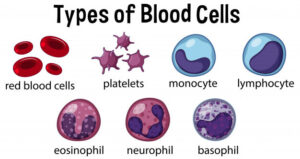
2)WBCs are the soldiers of the body’s Defence System. They are round, semi-transparent cells containing a nucleus and visible only under a microscope.
They are a little larger than RBCs. WBCs are far less numerous than RBCs. In normal conditions, the proportion of WBCs to RBCs is 1:400-500.
FUNCTIONS OF WBCs-
Broadly WBCs acts as a Defence system in the body. There are several varieties of WBCs performing specific functions. Different types of WBCs are following.
NEUTROPHILS(about 65-70 pc)-
Neutrophils are by far the most numerous of the white cells. They attack the invading bacteria and engulf them.
LYMPHOCYTES(about 25 pc of WBCs)-
Lymphocytes are second only to Neutrophils and produce antibodies that protect the body against antigens (a foreign substance like bacteria, viruses and toxins, etc.)thereby providing immunity against infections.
BASOPHILES-
Basophils secrete an anticoagulant called heparin that prevents clot within the blood vessels.
EOSINOPHILS and MONOCYTES –
Eosinophils become active against specific antigens. These work by swallowing up foreign particles in the body.
3)BLOOD PLATELETS( THROMBOCYTES)-
Blood platelets are tiny, circular or oval colourless cells, a quarter of the size of WBC, which clump together to release thromboplasm. Living only for a few days, platelets set off blood clotting, a mechanism that seals tears in blood vessels.
Blood platelets are irregularly shaped, colourless, refractile bodies, much smaller than the RBCs. Each contains the central chromatin mass resembling a nucleus.
Blood platelets possess the power of amoeboid movement. When blood is shed, they rapidly disintegrate and form granular masses, setting free prothrombin and the substance William Howell called thromboplastin.
PLASMA-
Plasma (the watery part) is a clear, yellow fluid, that constitutes up to 50-60 pc of the total blood. It transports blood cells and contains about 90 pc of water, protein and inorganic salts.
Organic substances such as glucose, amino acids, fats, urea, hormones and enzymes occur in the plasma either suspended or dissolved.
It also transports nutrients from the small intestine to the body tissue and returns the waste materials to the kidney, where they are filtered out. The proteins in plasma include antibodies.
BLOOD GROUPING-
Red blood cells have certain proteins on their surface called antigens. There are various types of red blood cells antigens-the ABO and rhesus types are most important-
ABO TYPES-
If you have type A antigen on the surface of your red blood cells, you also have anti- B antibodies in your plasma.
If you have type B antigen on the surface of your red blood cells, you also have anti -A antibodies in your plasma.
If you have type A and type B antigen on the surface of your red blood cells, you do not have antibodies to A and B antigens to your plasma.
If you have neither type A nor type B antigens on the surface of your red blood cells, you have anti -A and anti -B antibodies in your plasma. Look at the image.
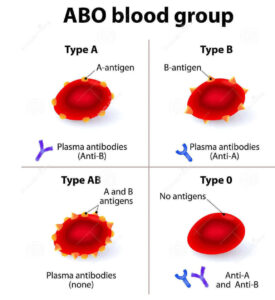
It means if you are A blood group person, so you will have A antigen on your blood and you will be compatible with the other person, who have A antigen(A BLOOD GROUP) or NO antigen (O BLOOD GROUP) in their blood group.
This means only blood group A and blood group O person can donate their blood to the person having blood group A.Look at the chart below of blood group.
Rhesus types-
Most people are rhesus positive, as they have rhesus antigens on their red blood cells. But about 3 in 20 people do not have rhesus antibodies and are said to be rhesus negative.
Blood groups name-
Your blood group depends on which antigens occur on the surface of your red blood cells. Your blood group is said to be:
A+(A positive), if you have A and rhesus antigen.
A-(A negative) if you have A antigens but not rhesus antigens.
B+(B positive) if you have B and rhesus antigen.
B-(B negative) if you have B antigen but not rhesus antigen.
AB+(AB positive) if you have A, B and rhesus antigen.
AB-(AB negative) if you have A and B antigen but not rhesus antigen.
O+(O positive) if you have neither A nor B antigens but you have rhesus antigens.
O-(O negative) if you do not have A, B or Rhesus antigens.
BLOOD COMPATIBILITY-
If you have a blood transfusion, it is vital that the blood you receive is compatible with your own. For example, if you receive blood from a person who is A positive and you are B positive then the anti-A antibodies in your plasma(described in ABO TYPES) will attack the red blood cells of the donated blood.
This causes the red blood cells of the donated blood to clump together. This can cause a serious or even fatal reaction in your body.
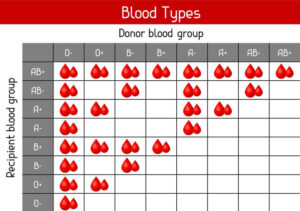
So before a blood transfusion is done. A donor bag of blood is selected with the same ABO and rhesus blood group as your self. Then, to make sure, there is no incompatibility, a sample of blood is mixed with the sample of donor blood.
After a short time, the mixed-blood is looked at under a microscope to see if there has been any clumping of blood. If there is no clumping, it is safe to transfuse the blood.
The above image shows that negative blood group are compatible with their corresponding negative blood group to donate and accept.
BLOOD GROUPS-
In 1902, K.landsteiner classified human blood into 4 groups, ‘A’, ‘B’, ‘AB’, ‘O’. Else for ‘O group, all others contain the corresponding antigens or ‘B’. Therefore the person with ‘O’ group is called the universal donor and can donate blood to all those having other blood groups.
Also, group ‘AB’can receive blood from all other groups and therefore is called the universal recipient.
| blood group | can donate blood to | can receive blood from |
| A | A and AB | A and O |
| B | Band AB | B and O |
| AB | only AB | AB, A, B and O |
| O | AB, A, B and O | Only O |
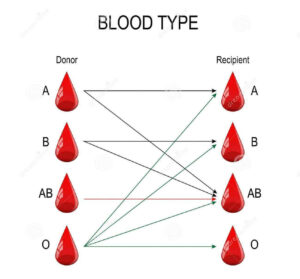
That means blood transfusion will only be applicable to the same antigen blood group of donor and receiver. Because the same antigen of the recipient is matched with the same antigen of the donor, so they become compatible.
If different antigen of the donor will come to the recipient then the recipient’s blood will produce antibodies against the different antigen of the donor.
SOME IMPORTANT TERMS-
BLOOD CLOTTING-
Blood clotting is the body’s Defence system to combat bleeding. plasma contains fibrinogen, a soluble protein of the blood, which produces the insoluble protein called fibrin, essential for blood coagulation. Fibrin is formed in the liver.
PROCESS OF CLOTTING-
Blood platelets break down in the vicinity of an injury and release an enzyme, which causes the formation of fibrin from fibrinogen. Fibrin forms a tangled mass of fibres which shrink and form a hard clot to plug the opening of the blood vessels.
After clotting, a straw-coloured fluid, called serum, remains. This portion of blood retains its liquids form indefinitely.
Rh FACTOR-
A blood antigen discovered in 1940 by Land Steiner and A.S.Wiener. Rh factor is another blood grouping that has an important bearing on blood transfusion along with the A, AB, O blood grouping. It is an agglutinogen found in the RBCs of most people and is called Rh+.
It was initially found in the rhesus monkey and later on in man. People who do not have this antigen in their blood are called RH-. The Rh-blood does not carry anti -Rh antibodies naturally. But could synthesise them if sensitized through blood transfusion of Rh + blood.
If Rh + blood is transfused into an Rh – patient, the serum will produce anti – Rh agglutinin. If another dose of Rh +blood is given the anti –ve Rh agglutinin will cause clumping of RBCs in the donor’s blood. As soon as it enters the patient receiving it.
Read also…What is gene
BLOOD TRANSFUSION-
The injection of blood from one person ( the donor) into the circulatory system of another is called a blood transfusion. It is used to make up a loss in the volume of blood or to improve its composition. A rapid loss of 3-3.5 L of blood can be fatal unless it is properly replaced by transfusion.
Blood transfusion is done after the proper matching of blood groups and the Rh factor. The technique was first developed by James Blundell(London) in 1825.
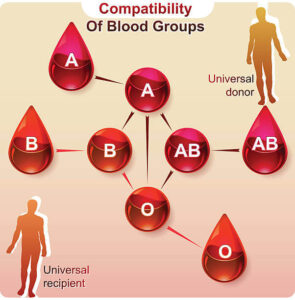
Read also… Health and hygiene
BLOOD PRESSURE-
It is the force exerted by the blood beating against the artery walls. As blood is ejected from the left ventricle into the aorta, there is an increase in blood pressure. As the ventricle begins to relax, the pressure falls.
The highest point in the pressure range is called systolic pressure(upper reading) and the lowest point in the pressure is called diastolic pressure( lower reading).
Blood pressure is measured in the large artery of the arm, called the branchial artery, using a sphygmomanometer. The diastolic pressure is always lower than the systolic pressure.
The average systolic pressure of a healthy young man of 20 years of age is about 120 mm Hg.and the diastolic pressure about 80 mm Hg, that is,120/80is the normal blood pressure.
Any systolic pressure over 140 or diastolic pressure over 100 is considered abnormal. High blood pressure or hypertension may be caused due to excitement while low blood pressure or hypotension may result from malnutrition and other factors.
Blood pressure depends on many other factors including the strength of the heartbeat, volume and thickness of blood, elasticity of the arteries and resistance to blood flow offered by capillaries.
Thank You
Read also…
